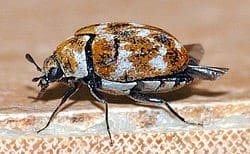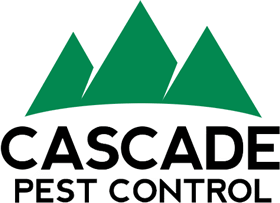
Facts About Carpet Beetles
Carpet Beetles are small (1/16” – 1/8”) oval-shaped pest that look almost like a ‘dull-colored’ lady bug with undefined or ‘smeared’ spots of white and brown with hints of yellow and orange. Adult carpet beetles emerge between late May and again in early August to feed on pollen and nectar from flowering plants and typically have a life span of 1-3 years.
Females lay around 50-100 eggs on food sources – such as woolen fabrics, fur, silk, leather, feathers, and carpets – and within a few weeks, hatch into fabric-eating larvae. Larvae hatch in the spring and early summer are roughly 1/8”-1/4” long, have tannish brown in color, and have thick hair-like bristles. The larvae will typically feed within fabric seams and folds (such as collars, coat lapels, hems, etc.), in closets and chests where feeding-fabric items are stored and idle for long periods of time, and undersides of rugs that are not in high traffic areas.
Some signs that you have a carpet beetle infestation are:
- The shed skins left behind by larvae
- Dead carpet beetles on windowsills
- Threadbare spots worn through clothing, blankets or carpets
- Irregular holes in woolen clothing, blankets or rugs
Because of the fabric damage caused by carpet beetles, they are often mistaken for clothes moths. Carpet beetles can thrive on lint, hair, and debris collected in and around vents and ducts, chimneys, basements, and more. And because of their diet and nesting behavior, it makes them challenging to control and manage because they can infest any area of your home!
CARPET BEETLE TREATMENT PREPARATION INSTRUCTIONS
The preparations below are required prior to your technician’s arrival; If prep is not completed it may result in a service fee and rescheduling of the initial treatment
Prep check list
House preparation – must be done before technician arrives
- If the bedding is wool remove from the bed and have dry cleaned. Do this first so that you can stack items on the bed if need be
- Clean out all closets (floors, shelves and hanging items) and under beds. Include storage closets, linen closets etc. Throughout the home
- Clothing dressers pull out clothes, remove empty drawers and stack the drawers facing the same direction. Armoire/wardrobe closet same as above
- Clothes – polyester and most cottons can be stored on top of the beds or tables. Some cottons may be vulnerable to carpet beetle best to hot wash and hot dry. Wools, silks and cashmeres should be drycleaned.
- Hides can be attacked also, hunting trophies, animal skin rugs, and wall hangings may need examined by a taxidermist.
- Help make baseboards accessible—move small items, toys, etc. (not required to move large furniture.) However, if furniture sits over wool carpet, it may become necessary to move should beetle persist.
Kitchen preparation – Carpet beetle feed on a variety of items including stored foods
- Empty cupboards, drawers with food and store items on kitchen table in boxes on the floor under the tables. it is best to leave countertops clear
- Check each food item removed for carpet beetle larvae as you go, infested items are to be discarded.
- Any pet food needs to be checked and stored in sealed containers.
Bathroom/Laundry: Empty cabinets including under the sink. Keeping the baseboards and countertops clear,
items can be stored in boxes on the floor. Clean Under dryer, dryer vent, under wash machine as lint will build up
in these areas and attract carpet beetle.
Vacuum all carpets and baseboard areas, paying attention to baseboard edges as hair and other
debris collect here even on tile, vinyl or wood floors. Under the washer and dryer, under beds and other
appliances
The more thorough the preparation, the more precisely we can inspect and treat!
Questions? Call 888-989-8979 for immediate service!
© 2020 Cascade Pest Control.
